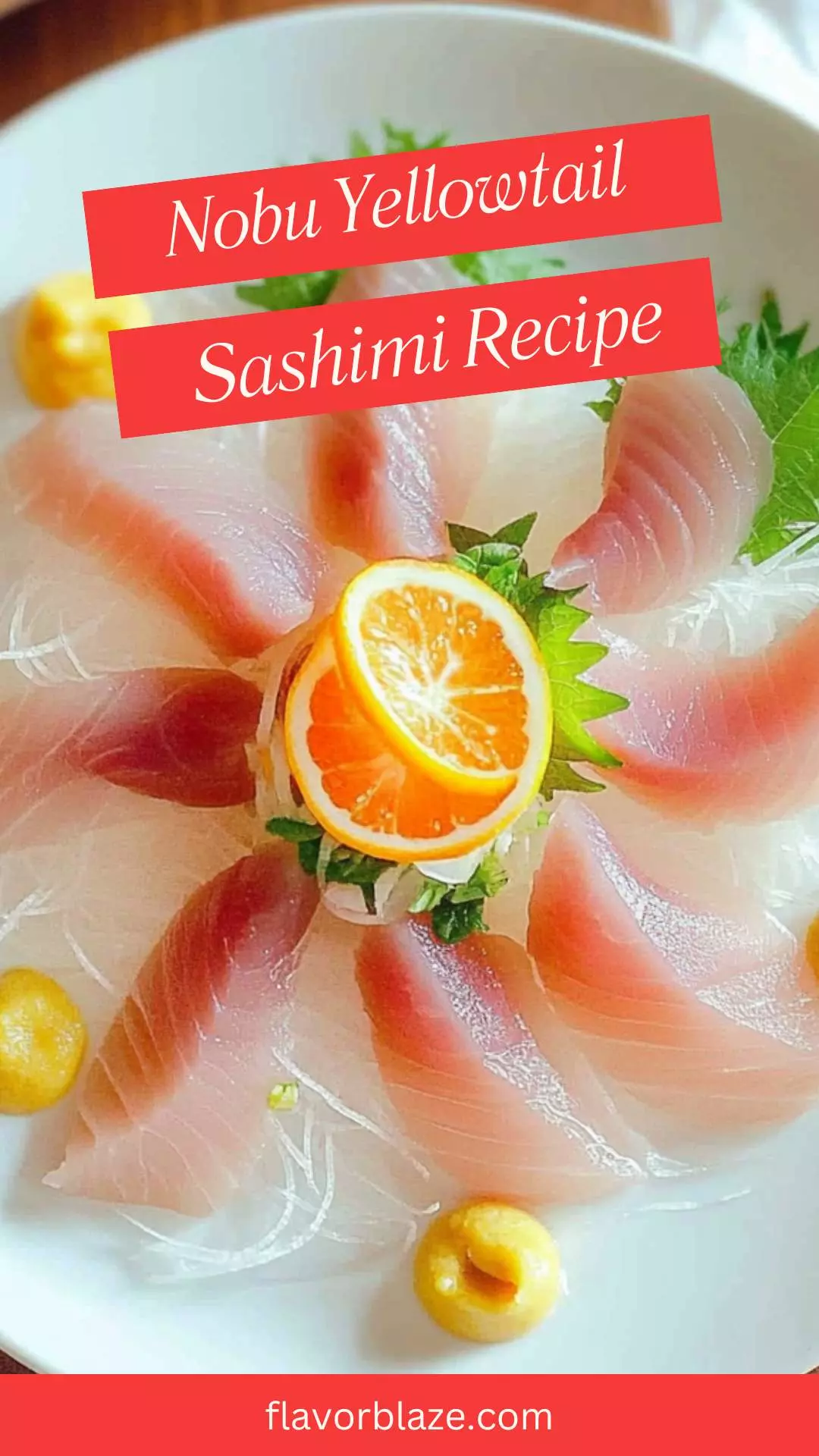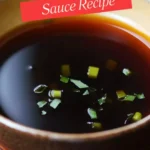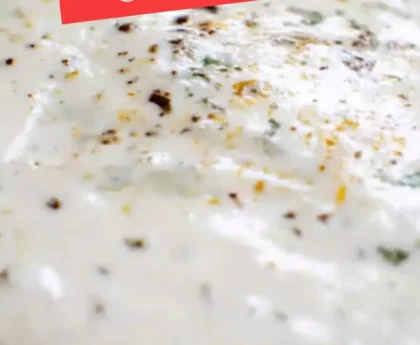Before diving into the delectable world of Nobu yellowtail sashimi, let’s talk about what pairs perfectly with this dish. First off, a subtle wine can elevate the seafood experience. A dry white wine or a light sake works wonderfully.
For those who prefer non-alcoholic options, a refreshing cucumber or mint lemonade will do the trick. Side dishes such as avocado salad, edamame, or a light miso soup provide a delightful contrast, enhancing the overall dining experience.
And, to really kick things up a notch, consider serving this sashimi with some crispy rice or tempura vegetables. Now, with your palate primed, let’s jump right into this culinary adventure!
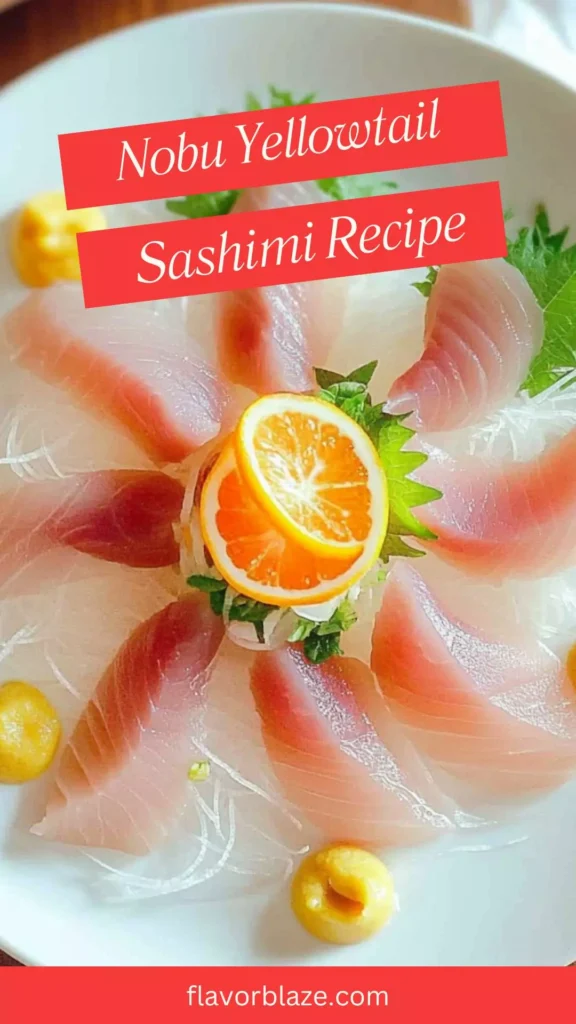
Imagine yourself at a chic restaurant, the dim lights creating an intimate atmosphere. You take your first bite of Nobu yellowtail sashimi. The fresh, tender fish practically melts in your mouth.
The zesty citrus and soy sauce danced around the pure flavor of the yellowtail. This is not just a dish; it’s a moment. For those of us who seek gourmet experiences without the need for a reservation, making this dish at home is a game-changer.
As a registered dietitian and food enthusiast, I can assure you that recreating the magic of Nobu yellowtail sashimi is within your grasp.
With just a handful of ingredients and a bit of time, you can impress family and friends with this stunning dish. The balance of flavors and textures will leave everyone asking for seconds. Let’s explore the intricacies of this delightful dish together!
What is Nobu Yellowtail Sashimi?
At its heart, Nobu yellowtail sashimi showcases the beauty of fresh ingredients. This dish features sushi-grade yellowtail, also known as hamachi, which is highly prized for its rich, buttery flavor.
It’s commonly served raw and sliced paper-thin, allowing the fish’s unique qualities to shine. It’s often complemented by a variety of garnishes and a signature sauce, enhancing both the taste and presentation.
The origins of yellowtail sashimi trace back to Japanese culinary traditions. Here, freshness reigns supreme, and the careful preparation is vital.
When prepared well, yellowtail sashimi exemplifies the philosophy of simplicity in Japanese cuisine: using only the highest quality ingredients to create a memorable dish.
Why You’ll Love Nobu Yellowtail Sashimi
Nobu yellowtail sashimi isn’t just food; it’s an experience. The first reason to love this dish is the flavor profile. The buttery yellowtail harmonizes beautifully with the citrusy sauce.
This combination tickles the palate while keeping it light—a perfect balance.
Additionally, the visual appeal is undeniable. Thinly sliced fish arranged artfully on a plate, crowned with fresh garnishes, creates a feast for the eyes. You know what they say, “You eat with your eyes first.”
Health enthusiasts will also appreciate the nutritional benefits. Yellowtail is packed with omega-3 fatty acids, essential for heart and brain health.
With fewer calories and fats compared to other protein sources, this sashimi suits various dietary preferences, including those looking for lighter meal options.
Moreover, preparing Nobu yellowtail sashimi might become your new favorite party trick. Imagine serving this exquisite dish at your next gathering. Your friends will be amazed, and your culinary skills will be the talk of the town.
The Ingredients You Will Need to Make Nobu Yellowtail Sashimi
To create this remarkable dish, you’ll need the following ingredients:
- Yellowtail Sashimi
- 5-6 oz sushi-grade yellowtail (hamachi) fillet
- Optional Garnishes
- 5-6 thin slices of fresh jalapeño
- 5-6 thin lemon slices
- ½ teaspoon freshly grated wasabi
- 1 tablespoon thinly sliced pickled ginger
- 1 teaspoon sesame oil
- Citrus Soy Yuzu Ponzu Sauce
- 1 tablespoon tamari or soy sauce
- 1 tablespoon citrus-infused ponzu sauce
- ¼ teaspoon freshly pressed or finely minced garlic
With these ingredients, you’re well on your way to mastering this dish.
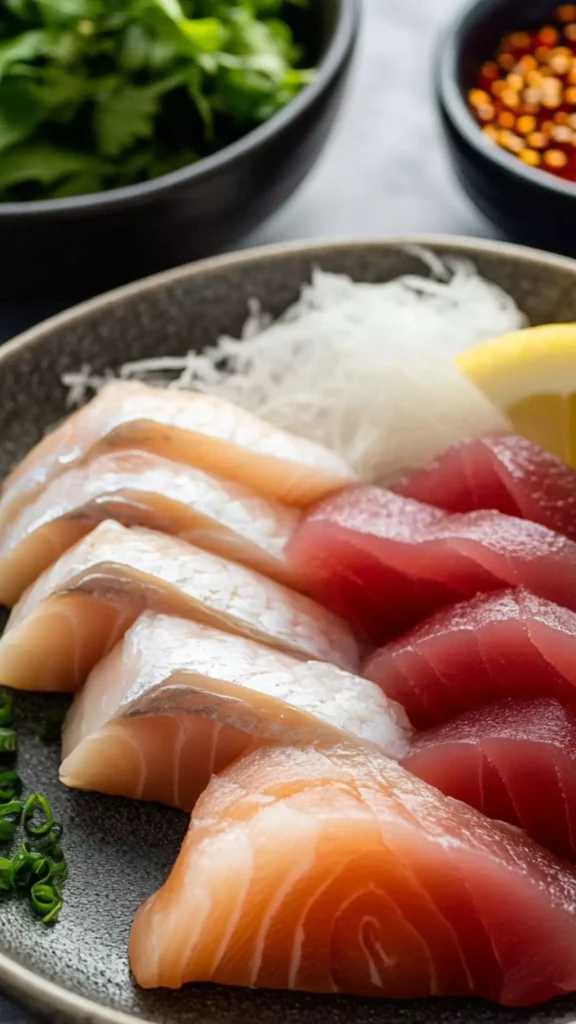
Directions to Prepare Nobu Yellowtail Sashimi
Here’s a step-by-step guide to making your very own Nobu yellowtail sashimi. Let’s get to slicing, seasoning, and serving!
Step 1: Prepare the Ingredients
Start by ensuring all your ingredients are ready. This means thinly slicing the yellowtail against the grain. Aim for about ¼ inch thick slices. The texture matters here; thinner pieces should allow the fish to melt in your mouth.
Step 2: Make the Sauce
In a bowl, mix the tamari or soy sauce with the citrus-infused ponzu sauce. Add the minced garlic and stir until combined. This sauce elevates the flavor of the sashimi, so don’t rush this step!
Step 3: Arrange the Sashimi
On a serving platter, artfully arrange your yellowtail slices. You can fan them out or stack them for a more modern presentation.
Step 4: Garnish
Now, it’s time to have some fun. Add the jalapeño and lemon slices over the sashimi. These not only add color but also provide a zesty kick. If you enjoy the heat, sprinkle some freshly grated wasabi on top.
Step 5: Drizzle the Sauce
Take your prepared sauce and drizzle it generously over the sashimi. For those who prefer, you can serve the sauce on the side for individual dipping.
Step 6: Finish with Pickled Ginger and Sesame
Finally, take the thinly sliced pickled ginger and scatter it around the plate. Drizzle the sesame oil over the sashimi for an additional flavor enhancement.
Now, your Nobu yellowtail sashimi is ready to be enjoyed!
Notes: Tips for Perfecting Your Sashimi
Here are some valuable tips to ensure your dish tastes as great as possible:
- Choose the Best Fish: Always opt for sushi-grade fish from a reputable supplier. Freshness is crucial.
- Keep Everything Cold: Work on a cold surface and chill your plates to keep the fish firm and fresh.
- Use a Sharp Knife: A sharp knife is essential for clean cuts. Dull knives crush the fish instead of slicing it.
- Experiment with Sauces: While the Yuzu Ponzu sauce is great, feel free to try different flavors, like soy with chili oil for a spicy kick!
- Garnish Smartly: Don’t hesitate to add herbs like cilantro or thinly sliced green onions for additional flavor and visual appeal.
Storage Tips
Storing sashimi can be tricky due to its delicate nature. Follow these guidelines for the best results:
- Refrigerate Immediately: If you have leftovers, cover them with plastic wrap and store in the coldest part of your refrigerator.
- Consume Quickly: Aim to eat any leftovers within 24 hours. The fresher, the better!
- Avoid Freezing: It’s best not to freeze sashimi, as it may compromise the texture and flavor.
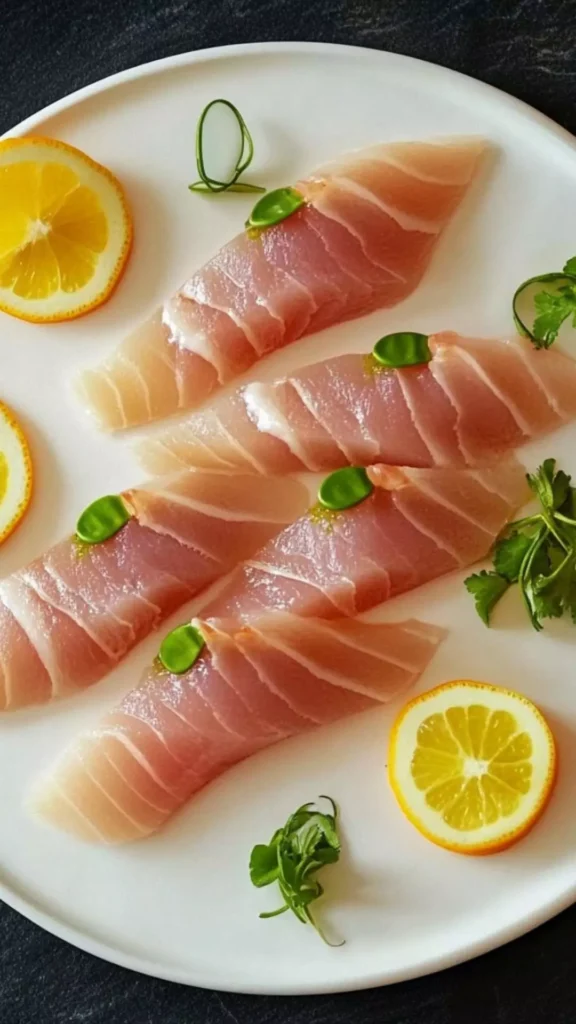
Serving Suggestions
To elevate your sashimi experience, here are some serving suggestions:
- Cucumber Salad: Serve with a refreshing cucumber salad, drizzled with rice vinegar. The light crunch complements the sashimi wonderfully.
- Sushi Rice: Pair with seasoned sushi rice for a more filling meal. The rice provides a nice balance and adds substance.
- Seaweed Salad: A side of seaweed salad adds an extra layer of flavor. The umami-rich salad pairs well with the yellowtail.
- Pickled Vegetables: Consider pickled vegetables for a pop of acidity. They add a great contrasting flavor that enhances the sashimi.
- Sake Tasting: Host a sake tasting alongside your sashimi for a full sensory experience. Different flavors can bring out unique notes in the fish.
Other Substitutes You Can Use in Nobu Yellowtail Sashimi
If yellowtail isn’t available or you want to try something different, here are some substitutions:
- Tuna (Maguro): Rich and meaty, tuna offers a different flavor but works well in sashimi. Its red color provides a stunning visual contrast too.
- Salmon (Sake): Fatty and flavorful, salmon sashimi is a popular alternative. It’s commonly found and loved for its silky texture.
- Snapper (Tai): Snapper offers a milder flavor and a firm texture. It’s an excellent option for those who prefer something less bold.
- Mackerel (Saba): Mackerel adds a deep flavor profile, rich in omega-3 fatty acids. It’s often marinated before serving, enhancing its taste.
- Scallops (Hotate): Sweet and delicate, scallops can serve as a luxurious swap. They melt in the mouth and offer an ethereal sushi experience.
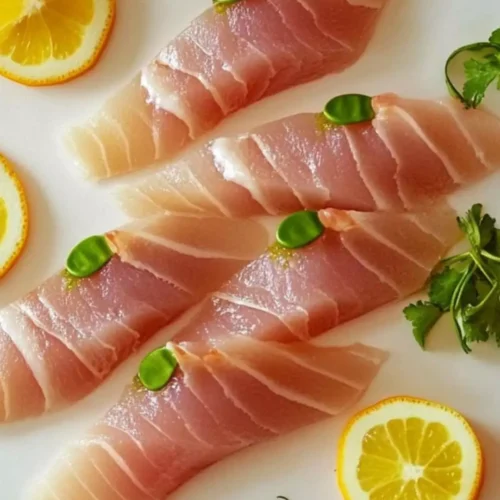
Nobu Yellowtail Sashimi Recipe
Equipment
- Bowl
Ingredients
- 5-6 oz sushi-grade yellowtail hamachi fillet
- Optional Garnishes
- 5-6 thin slices of fresh jalapeño
- 5-6 thin lemon slices
- ½ teaspoon freshly grated wasabi
- 1 tablespoon thinly sliced pickled ginger
- 1 teaspoon sesame oil
- Citrus Soy Yuzu Ponzu Sauce
- 1 tablespoon tamari or soy sauce
- 1 tablespoon citrus-infused ponzu sauce
- ¼ teaspoon freshly pressed or finely minced garlic
Instructions
- Start by ensuring all your ingredients are ready. This means thinly slicing the yellowtail against the grain. Aim for about ¼ inch thick slices. The texture matters here; thinner pieces should allow the fish to melt in your mouth.
- In a bowl, mix the tamari or soy sauce with the citrus-infused ponzu sauce. Add the minced garlic and stir until combined. This sauce elevates the flavor of the sashimi, so don’t rush this step!
- On a serving platter, artfully arrange your yellowtail slices. You can fan them out or stack them for a more modern presentation.
- Now, it’s time to have some fun. Add the jalapeño and lemon slices over the sashimi. These not only add color but also provide a zesty kick. If you enjoy the heat, sprinkle some freshly grated wasabi on top.
- Take your prepared sauce and drizzle it generously over the sashimi. For those who prefer, you can serve the sauce on the side for individual dipping.
- Finally, take the thinly sliced pickled ginger and scatter it around the plate. Drizzle the sesame oil over the sashimi for an additional flavor enhancement.
- Now, your Nobu yellowtail sashimi is ready to be enjoyed!
Notes
- Choose the Best Fish: Always opt for sushi-grade fish from a reputable supplier. Freshness is crucial.
- Keep Everything Cold: Work on a cold surface and chill your plates to keep the fish firm and fresh.
- Use a Sharp Knife: A sharp knife is essential for clean cuts. Dull knives crush the fish instead of slicing it.
- Experiment with Sauces: While the Yuzu Ponzu sauce is great, feel free to try different flavors, like soy with chili oil for a spicy kick!
- Garnish Smartly: Don’t hesitate to add herbs like cilantro or thinly sliced green onions for additional flavor and visual appeal.
Nutrition
Frequently Asked Questions
Conclusion
Nobu yellowtail sashimi is more than a dish; it’s a triumph of simplicity and flavor. Mastering it at home opens the door to a world of culinary discovery. You can impress your guests, indulge in a personal treat, or simply enjoy the act of creating something beautiful and delicious.
With the right ingredients and a few straightforward steps, you can bring a piece of fine dining into your kitchen.
So grab your freshest yellowtail and get started! Your taste buds and dinner guests will thank you.

